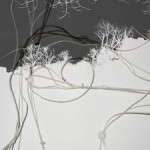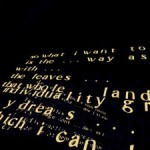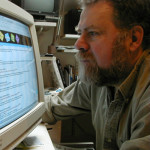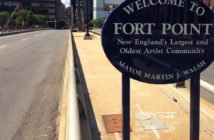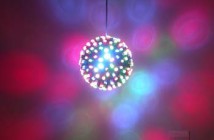MR: The Boston CyberArts Festival is moving in the direction of being quite comprehensive. You have everything from an exhibition in MFA, to dance performances, exhibitions in newly developed buildings to individual artists showing in galleries. When you started the CyberArts Festival, was that something you wanted to make sure would happen, or did it just happen?
GF: In a way it just happened. When I started the Cyberarts, in 1997 and 1998, I applied for the Mass Cultural Council Grant for the first Cultural Economic Development grant. It was the first CED they ever did, and we got it. It was a considerable amount of money for two years to plan and implement the Festival.
But even then, though I had the model in my head of us being, essentially, an umbrella organization. I asked all these other organizations to participate within their own mission. Even then I thought it would be a very successful Festival if 20 organizations joined in, and that first Festival we had 60. It was clearly a conversation whose time had come, and everybody needed a context in which to have it.
MR: The Berwick’s first ‘legitimate’ art show, curated by Dave Webber, was “Quadraphonia” in 2001. CyberArts brought us a context and the motivation to pull it off.
GF: Good! In that sense it has been very successful. And now organizations are putting on shows about art and technology, about new media, without waiting for the Festival. New media is now a part of the general conversation, and even though I see a show and I think I wish that they’d waited a couple weeks, a couple months to do it during the Festival because it would have been a great Festival show it is clear that everybody has had the conversation and it is continuing to happen. I’m very pleased about that.
The impetus behind the show happened in 1993 when I was asked to start writing a column for Art New England called “Art and Technology”. In researching the column, I came across this incredible 50-year history of artists working with new technologies in the Boston area, and nobody knew about it.
And then outside of that you have this incredible technological fount that keeps expanding. So there are lots of individual stories.
One of my favorites, that have only come to light in about the last five years, is the close working relationship someone like Ed Land had with Ansel Adams. Land would ship every prototype Polaroid camera to Adams out in Yosemite, and Adams would put it through its paces and write long letters back about This is really not so great, this is wonderful and so on. They basically worked on it together.
There are lots of stories like that. This artist-engineer collaboration has been going on for years, and yet from the point of view of the Boston art scene, it was invisible and nobody knew about it. The Boston art scene was all expressionist painters and complaints about why we’re not like New York.
MR: But now I feel as if, through the Festival, there is a kind of collective identity. I was also pleased to see so much dance work in this Festival.
GF: For the very first Festival, Dance Umbrella brought the prestigious Marie Chouinard Dance Company down from Montreal. This conference is a direct result of Dedalus Wainwright, his friend Alissa Cardone, and Neil Breyer coming together and saying We’d like to do this and I just said OK, Boston CyberArts will go out and raise the money and make it happen but they have been doing all the work.
I think it will be hugely successful, because they will be bringing troupes to town that haven’t been here before, and re-creating some famous dances from the ‘70s.
MR: I’m struck by the collective willingness of the larger art institutions to participate. Like the Isabella Stewart Gardner Museum. They do music performances, an artist-in-residence, and they have an art show up. You have given people an impetus to create works and exhibitions under the Festival.
GF: It’s not quite as natural as it looks (laughter).
MR: Tell me about that, then.
GF: This is why we need two years, we couldn’t do it every year, and why you have to spend a lot of that time just talking to a lot of organizations and getting to know a lot of people in town, and just pushing and saying what are you going to do for the Festival?
We have a couple of great sponsorship situations this year. The company that is building the biotech Kendall Square area up, Lyme Properties, is giving us four first-floor retail spaces at the Genzyme Building and the Vertex Building in Kendall Square to put on exhibits. That is really great.
MR: Did they give you a blank slate? Or did they say This is what we want to see here?
GF: No no, they really didn’t know what they wanted. They just wanted to bring some life to the area. They have just built it up, and they’re in the process of putting in some condominium buildings and so they’re really trying to invigorate the area. It is a biotech area, so there’s the idea that we’re bringing technological art. One of the pieces that has a real biotech, technological aspect is Bill Seamen’s “The Thoughtbody Environment”. In sort of poetic way he is discussing what it would be like, what are the conditions necessary, to start thinking about biological computers. So it fits in perfectly.
MR: So, your audience will go to those spaces and will find themselves in a newly developed building within a neighborhood of biotech corporations. The artworks themselves push both art and technology and their locations also push lines of technology and living spaces... I think this is compelling territory.
GF: One of the hardest things about doing the Festival is when you have sixty different locations, having people understand that they are all part and parcel to the same thing. So, there are some issues there, but The Boston Phoenix has been our sponsor for many years. They’ve been great, and Big RED doing articles like this. By the time the Festival arrives, everyone already knows what to expect, or they know where to get the information.
MR: Also, the artists and curators have been thinking about the Festival since the call went out in August of last year, so it’s a big bright spot on our calendars.
I’m really happy to see Heather Kapplow is bringing artist from Finland. So there’s this international feel.
GF: I really want the Festival to be an international event. I want people to not only exhibit artists from all over the world, but for the audience to come from all over the world to attend the Festival. We’ve had some organizations that have been incredibly supportive, most notable the Goethe Institute. The Goethe Institute has, for every Festival, brought a major German artist to participate. This year it is Tamiko Thiel and Zara Houshmand. Last year, they brought Berkan Karpat.
MR: There is also Rennsalear PolyTech, and RISD artists representing young artists in educational institutions. What do you think about these of student works?
GF: There are two shows encompassing numerous graduate programs. The Lyme Property is showing work by graduate students from RISD, Brown, and RPI. At MassArt, there is a show with students Emerson, Museum School and MIT.
MR: That’s great that there is a cross-pollination of students. Often an MIT student might see a MassArt student at a party, or a lecture, or do electronic projects workshop or something, but exhibiting together is a great way to collaborate, and may be rare.
GF: It’s worse for the faculty. I would say Boston is a city of ivy-covered foxholes, and the faculty tend to be hunkered down within their own institutions. They may meet each other across the country, 3000 miles away at a conference, rather than the half-mile away where their offices are.
For instance, when we started the first Festival, I discovered that every major college around here has an important new music laboratory with a world-renown composer in charge of it, and it was the first Festival we started bringing them all together. That first Festival programmed an evening at the Middle East where Brandeis, MIT and Harvard faculty all got together to put on performances. And that doesn’t really happen. That’s one of the great things about the Festival; we’re able to jump over all these boundaries.
MR: Tell me a little about your organization. You’re a 501(c)(3), and you have a small staff...
GF: A variable staff. In the summer after the Festival it shrinks down to me and my dog, and a little help here and there from others. But now, it grows to about ten people, including interns, working close to full-time on it. So, it’s nice that it can ebb and flow like that.
MR: Between the Festivals, you did a residency?
GF: That was a first for last year. I’m organizing it again this summer, but we got a grant to make that happen. We had the two artists: Carrie Boodle and John Kilma; and two high-tech companies: the Collaborative User Experience Group and IBM and Plum Voice. The show of that is opening April 9 at the DeCordova.
MR: So your definition of CyberArts, in your mission, seems to be computer based. But the work seems to be much more wide-open.
GF: I like finding an artist working with new technologies, and I think that’s a particular view. These days that almost always means something to do with the computer, but the computer is so ubiquitous.
Still, in some cases, you’re dealing with people whose technology is biology. We had a very interesting one last Festival in 2003; we had a tissue-culture in art group from Perth, Australia, who had spent a year as artists-in-residence at Dr. Joseph Vacant’s organ fabrication laboratory at Mass General Hospital. The artists worked along side researchers and fabricated their own organs. In this case: pig’s wings. They were actually growing them out of pig cells, and subjecting them to pig tests. It was a great program. It was a great art program because they were showing what research was about, and what its hopes and fears were. They were managing to humorously address people’s deepest fears about technology. I give a tremendous amount of credit to Dr. Vacant for allowing these artists to use his lab.
MR: What do you think of the artists role in the research environment? Do you find that valuable?
GF: It’s not only valuable to the artists, it’s clear from the history of artist-residencies in research companies that it’s valuable to the researchers as well. Innovators see a problem and they come up with a solution. It’s not always that simple, but that is generally the role. Artists take the solution and try to figure out everything else they can do with it. Sometimes in doing so they can just break it, and let the shards fall at their feet. But in many cases the researchers look at what they were doing, and go This is incredible. We didn’t know this was an application for our solution. Everybody wins in that situation, and there is a long history of this.
We were talking about Ansel Adams earlier, and you can also at the long history of the artist-in-residence program at Xerox PARC. There is a long history, there are major examples of inventions that came out of what artists did.
MR: I would like to see art as a way of changing peoples’ views of the world. They have a mode of operation that is sort of suspension of disbelief. Artists can get out into the world and immediately test ideas that might take a long time in the traditional way of doing things.
Do you see some of that happening in this Festival?
GF: Yes, I see a thread in this Festival where artists are using satellite surveillance technologies. Landsat, GPS...
The Photographic Resource Center at Boston University, the 119 Gallery, and the Judi Rotenberg Gallery are all showing GPS related works.
MR: Tell me about the artist at Judi Rotenberg who is doing the tour with GPS.
GF: This is Teri Reub, who is doing a tour with GPS devices on PDAs. You go around an area outside, and by knowing where you are it will then give you information back.
There’s another really interesting one that is taking place in the Fens. An artist named Steven Holloway is going to do a performance/installation called “One Pixel Boston” in which he maps out exactly what one pixel looks like from a Landsat photo, which is huge. It’s thirty-three meters by thirty-three meters. Then students from the Boston Arts Academy will come and work with him and investigate this.
MR: Earlier this week I was looking at the website, and it’s very comprehensive. There are something like fifteen pages of events.
GF: Headquarters is Art Interactive. Every year we have a CyberArts central, and this year it’s going to be, again, at Art Interactive. There’s going to be a great exhibit there, but there is also going to be a home base to find out where everything is, you can talk to volunteers, buy t-shirts.
- Andrew Neumann, Wall Construction #1, from the exhibition The Science of Causes at the Art Instiute of Boston.
- John Cayley and Dmitri Lemmerman, Torus: works in progress, from the exhibition Works from the Cave II at David Winton Bell Gallery, Brown University. 2005.
- George Fifield, director of the Boston CyberArts Festival.
Links:
Boston CyberArts
The Berwick Research Institute
The Massachusetts Cultural Council
The Isabella Stewart Gardner Museum
Lyme Properties
The Boston Phoenix
Rennsalear PolyTech
The Rhode Island School of Design
Brown University
The Massachusetts College of Art
Emerson College
The School of the Museum of Fine Arts
The Massachusetts Institute of Technology
The Middle East
Brandeis University
Harvard University
The DeCordova Museum
The Photographic Resource Center (Boston University)
119 Gallery
Judi Rotenberg Gallery
The Boston Arts Academy
Art Interactive
"The Boston CyberArts Festival" is a city-wide event from April 22 thru May 8, 2005.
All images are courtesy of the artist and the respective venue.


